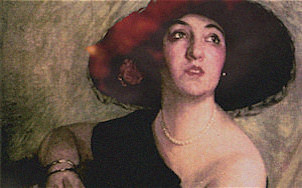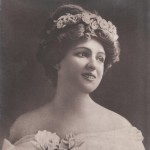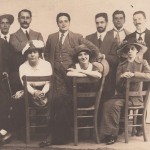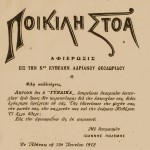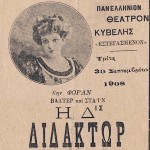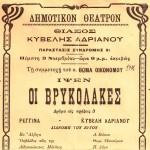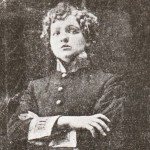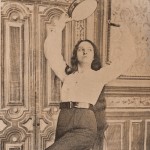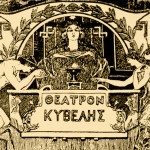Following her return from Paris in the summer of 1907, Kyveli reappeared on stage in Jules Renard’s Poil de Carotte, her first cross gender role, in which she excelled. During that summer season, she formed her own theatre company, to be managed by Theodoridis. The pair presented comedies, farces and boulevards as well as Ibsen’s Et Dukkehjevn (A Doll’s House) in 02/10/1907. The latter play became a fixture in Kyveli’s repertoire with Nikos Papageorgiou as Rank.
Most of the plays she staged were entertaining stage games dominated by conventional bourgeois ethics, adulterous affairs and stylish dialogue. Hence the famous boulevard playwrights’ pairings (De Flers and De Caillavet, Gavault and Berr, Veber and Hennequin, Bisson and Trarieux, etc) supplied the company with plays for many years. Kyveli specialised in characters of young girls which were written for her by Xenopoulos, Horn and Melas, and displayed a wide array of emotions in her interpretations: In Monakrivi (The One and Only) she was the young, spoiled bourgeois girl whose love is awakened from the blissful child’s sleep. In Fotini Sandri she was the proud peasant girl who died for her love. While in Peirasmos (Temptation) she played the illiterate, poor female struggling to survive in the world of the corrupt bourgeoisie.
From 1911 Kyveli cooperates with Thomas Oikonomou and is given the opportunity to present repertoire plays of quality during the literary evenings she has established at her company. The company stages mainly Ibsen, repeating A Doll’s House and Vildanden (Wild Duck), which even becomes a box office success. During the 1910s Kyveli’s troupe consolidates its repertoire’s choices focussing mainly on boulevard, farce and the modern Greek plays. In addition, the repertoire was interspersed with plays by Pirandello (whose plays were introduced to Greece by her company in 1914 with La Morsa), Tolstoy (Resurrection, 1911), Schnitzler (Countess Mizzie), Sudermann, Hauptmann (Helga, 1913), Wilde (A Florentine Tragedy, 1912, The Picture of Dorian Gray, 1916 and An Ideal Husband, 1917) and Strindberg (the one act plays Moderskärlek (Mother Love) and Den Starkare (The Stronger), 1917.
Naturally, several other playwrights also remained at the forefront like Veber, de Caillavet, de Croisset, Lavedan, Bataille, Berr, Bernstein, Bisson (whose La Femme X would become a significant success and would be adapted for the cinema in 1954) de Flers, Bracco and Niccodemi. Her acting in the forgotten Italian playwright’s Scampolo in 1915, had the whole of Athens talking about her.



